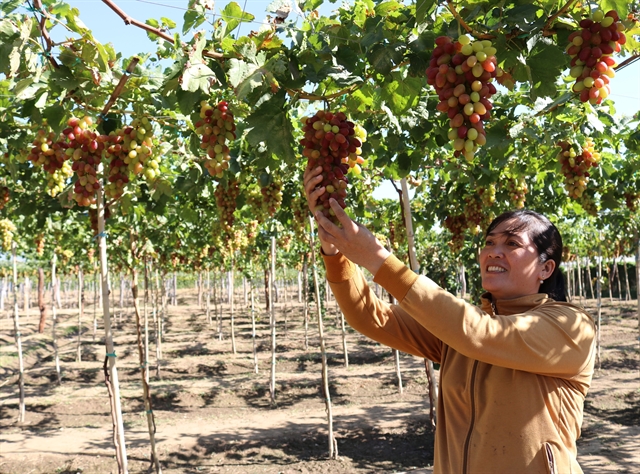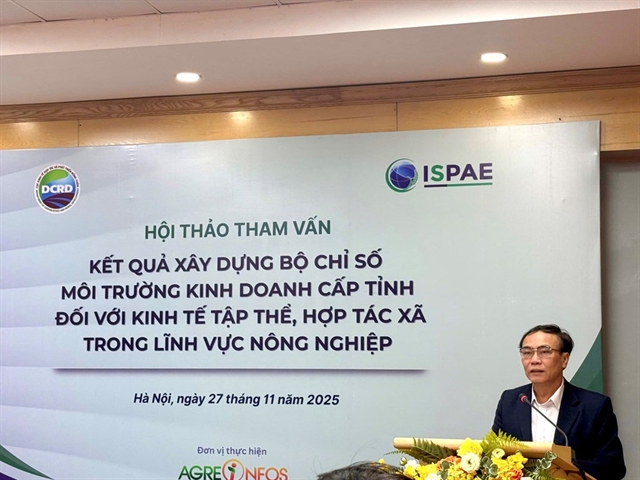 Society
Society

Ninh Thuận Province, the country’s largest grape producer, is targeting sustainable grape production after conducting research on new grape varieties, applying advanced farming techniques, and investing in post-harvest processing.

|
| A NH01-152 grape orchard in Ninh Thuận Province’s Ninh Hải District. — VNA/VNS Photo Nguyễn Thành |
NINH THUẬN — The south-central province of Ninh Thuận Province, the country’s largest grape producer, is targeting sustainable grape production after conducting research on new grape varieties, applying advanced farming techniques and investing in post-harvest processing.
Lâm Quang Thựu, deputy director of the province’s Department of Agriculture and Rural Development, said that farmers were working with companies to increase profits by producing grapes under value chains.
The south-central province, which has the least rainfall in the country, has more than 1,200ha of grape growing areas with an annual total output of 30,000 tonnes, with the red cardinal and the NH01-48 the two major grape varieties.
The province’s grape farming area accounts for less than 4 per cent of its farming area, but the revenue contributes 15-20 per cent of its total crop revenue, according to the Department of Agriculture and Rural Development.
The province’s grapes have been granted geographical indication certification by the National Office of Intellectual Property.
Despite this, the province’s grapes are less competitive compared to imported grapes in terms of quality and appearance. Most processed grape products are produced by individual households.
Phạm Châu Hoành, chairman of the province’s Jujube and Grape Association, said that linkages between stakeholders for grape production under Vietnamese good agricultural practices (VietGAP) standards were still modest.
The province has about 50ha of VietGAP grape cultivation, he said, adding that most grapes are sold fresh to wholesale markets.
Nguyễn Đương, who has grown grapes for 20 years in Ninh Hải District, said grape farmers were facing high prices for input materials, and unstable grape prices and outlets.
Climate change has affected grape cultivation, while many old grape varieties have declined in yield and quality, he said.
In recent years, the province has created several new seedless grape varieties like NH04-61, NH04-128, and NH01-152, and grows them on a pilot basis.
The NH01-152 variety, for instance, has an average yield of 15-18 tonnes per hectare a crop and two harvest crops a year.
The NH01-152 type can be grown in many types of soil, is highly disease-resistant, and has large and juicy fruits.
Nguyễn Văn Lợi in Ninh Hải District’s Vĩnh Hải Commune switched from growing an old grape variety to NH01-152 three years ago.
He grows the fruit under VietGAP standards and uses efficient irrigation facilities to save water. “After I switched to NH01-152 grape, I discovered that its quality is high and selling price stable.”
Traders buy NH01-152 at a price of VNĐ100,000 (US$4.3) per kg.
Nguyễn Khắc Phòng, director of the Thái An General Service and Agriculture Co-operative in Vĩnh Hải, said the price of NH01-152 is two to seven times higher than the province’s two main grapes, the red cardinal and NH01-48. NH01-152 provides high value for farmers.
The province’s People’s Committee has instructed the department and relevant agencies to cultivate NH01-152 to VietGAP standards via the province’s support programmes for ecotourism development and for growing grapes.
The province has about 10ha of NH01-152 and plans to expand the area to 20ha in 2020.
To improve grape value, the province is calling for more investment in grape products like wine, dried grapes, syrup and jam.
The province has also helped grape growers and processors introduce their products to modern distribution channels and participate in agricultural tourism programmes.
Many grape farmers have been offering tourism services at their grape orchards to improve income.
In 2020, the province aims to increase its grape area to 1,350ha with an annual output of 32,000 tonnes. — VNS




